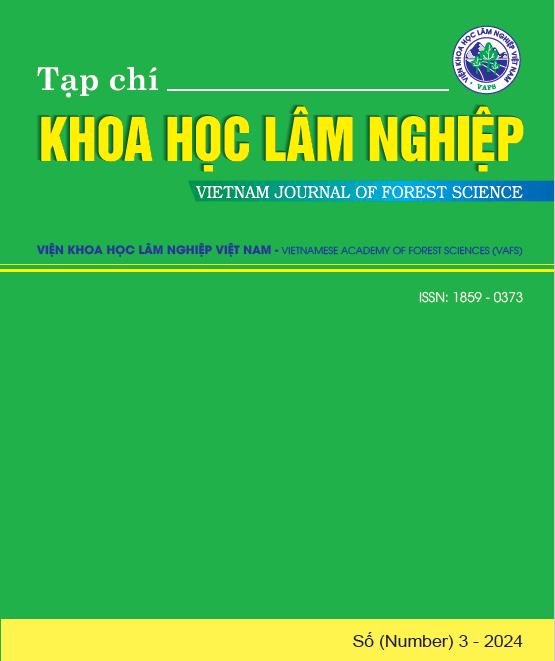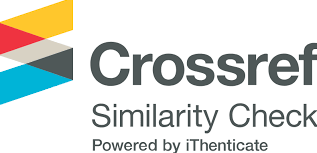DISTINGUISHING EDIBLE MUSHROOM (Russula griseocarnosa) AND POISONOUS MUSHROOM (Russula sp.) IN QUANG NINH PROVINCE
Keywords:
Edible mushroom, Fagaceae, Russula griseocarnosa, wild mushroomAbstract
SUMMARY
Russula griseocarnosa occurs naturally in Southern China and Northeast Vietnam, where it is widely used as food. In Quang Ninh province, this edible mushroom species (Nấm chẹo/nam cheo) grows wild in forests with Engelhardia roxburghiana trees and some chestnut species. However, in these forests there is another Russula species that is toxic and closely resembles R. griseocarnosa. The toxic species is called red mushroom (nam xop do), and it causes symptoms of dizziness and vomiting when eaten. This study aimed to provide basic data to distinguish the two Russula species. Based on the sequence of the ITS gene, it was concluded that the edible mushroom is Russula griseocarnosa, while the red mushroom is an unidentified Russula species. Morphological comparison of the two species revealed some distinguishing features, namely (1) nam cheo caps are a lighter color (pink or brick red) than red mushroom (red or bright red); (2) the mature cap of nam cheo is much thicker (1.5 - 2.1 cm) than that of red mushroom (1.0 - 1.2 cm); (3) The flesh inside the stalk of nam cheo is spongy and grayish white or gray in color, while the flesh inside the red mushroom stalk is white and not spongy. These findings will help collectors and housewives more readily distinguish between the nam cheo and red mushroom.
References
Adamčík, S., Caboň, M., Eberhardt, U., Saba, M., Hampe, F., Slovak, M., Kleine, J., Marxmueller, H., Jančovičová, S., Pfister, D.H. 2016. A molecular analysis reveals hidden species diversity within the current concept of Russula maculata (Russulaceae, Basidiomycota). Phytotaxa, 270 (2), 71-88.
Anh, C.N., Chi, N.M., Dell, B. 2024. Nutritional value of edible Russula griseocarnosa in Vietnam. Asian Journal of Agriculture and Rural Development, 14, 1-9.
Anh, C.N., Chi, N.M., Kiet, T.T., Long, P.D., Thuy, P.T.T., Loi, V.V., Dell, B. 2023. Morphological and molecular identification of an edible Russula mushroom in northeast Vietnam. Journal of Forestry Science and Technology, 15, 50-59.
Chen, X.H., Xia, L.X., Zhou, H.B., Qiu, G.Z. 2010. Chemical composition and antioxidant activities of Russula griseocarnosa sp. nov. Journal of Agricultural Food Chemistry, 58 (11), 6966-6971.
Hall, T.A. BioEdit: a user-friendly biological sequence alignment editor and analysis program for Windows 95/98/NT. In: Nucleic acids symposium series, 1999. vol 41. [London]: Information Retrieval Ltd., c1979-c2000., pp 95-98.
Ijioma, B.C., Ihediohanma, N.C., Onuegbu, N.C., Okafor, D.C. 2015. Nutritional composition and some anti-nutritional factors of three edible mushroom species in South Eastern Nigeria. European Journal of Food Science Technology, 3 (2), 57-63.
Kaewgrajang, T., Kaewjunsri, S., Jannual, N., Nipitwattanaphon, M. 2020. Morphology and molecular identification of some Lactarius and Russula species. Genomics Genetics, 13 (2&3), 44-58.
Kirk, P.F., Cannon, P.F., Minter, D.W., Stalpers, J.A. 2008. Dictionary of the fungi (10th ed.), CAB International. Wallingford, UK.
Melera, S., Ostellari, C., Roemer, N., Avis, P.G., Tonolla, M., Barja, F., Narduzzi-Wicht, B. 2017. Analysis of morphological, ecological and molecular characters of Russula pectinatoides Peck and Russula praetervisa Sarnari, with a description of the new taxon Russula recondita Melera & Ostellari. Mycological Progress, 16, 117-134.
Ming, T., Li, J., Huo, P., Wei, Y., Chen, X., 2014. Analysis of free amino acids in Russula griseocarnosa harvested at different stages of maturity using iTRAQ®-LC-MS/MS. Food Analytical Methods, 7 (9), 1816-1823.
Nguyễn Minh Chí, 2022. Báo cáo hàng năm đề tài “Bảo tồn nguồn gen Nấm chẹo tại tỉnh Quảng Ninh”, 68 pp. Trung tâm Nghiên cứu Bảo vệ rừng.
Nguyễn Minh Chí, 2023. Báo cáo hàng năm đề tài “Bảo tồn nguồn gen Nấm chẹo tại tỉnh Quảng Ninh”, 86 pp. Trung tâm Nghiên cứu Bảo vệ rừng.
Nguyễn Phương Đại Nguyên, 2017. Điều tra thành phần loài nấm lớn thuộc chi Russula Pers.: S. F. Gray, 1821 ở Vườn Quốc gia Chư Yang Sin, tỉnh Đắk Lắk. Hội nghị khoa học toàn quốc về sinh thái và tài nguyên sinh vật lần thứ 7, Hà Nội, 852-857.
Park, M.S., Fong, J.J., Lee, H., Oh, S.Y., Jung, P.E., Min, Y.J., Seok, S.J., Lim, Y.W. 2013. Delimitation of Russula subgenus Amoenula in Korea using three molecular markers. Mycobiology, 41 (4), 191-201.
Pérez-Moreno, J., Guerin-Laguette, A., Rinaldi, A.C., Yu, F., Verbeken, A., Hernández-Santiago, F., Martínez-Reyes, M. 2021. Edible mycorrhizal fungi of the world: What is their role in forest sustainability, food security, biocultural conservation and climate change? Plants People Planet, 3 (5), 471-490.
Power, R.C., Salazar-García, D.C., Straus, L.G., González Morales, M.R., Henry, A.G. 2015. Microremains from El Mirón Cave human dental calculus suggest a mixed plant-animal subsistence economy during the Magdalenian in Northern Iberia. Journal of Archaeological Science, 60, 39-46.
Trần Thị Phú, Trịnh Tam Kiệt, 2019. Một vài loài nấm mới ghi nhận cho khu hệ nấm Việt Nam tại núi Ngọc Linh tỉnh Quảng Nam. Tạp chí Sinh học, 41 (1), 27-33.
Trịnh Tam Kiệt, 2012. Nấm lớn ở Việt Nam, vol 2. NXB Khoa học kỹ thuật Hà Nội.
VTV, 2023. https://vtv.vn/suc-khoe/nguoi-dan-ong-bi-ngo-doc-sau-khi-an-nam-do-mua-ngoai-cho-20230623100810173.htm. Truy cập ngày 23/6/2023
Wang, X.H., Yang, Z.L., Li, Y.C., Knudsen, H., Liu, P.G. 2009. Russula griseocarnosa sp. nov. (Russulaceae, Russulales), a commercially important edible mushroom in tropical China: mycorrhiza, phylogenetic position, and taxonomy. Nova Hedwigia, 88 (1/2), 269-282.
White, T.J., Bruns, T., Lee, S., Taylor, J.W. 1990. Amplification and direct sequencing of fungal ribosomal RNA genes for phylogenetics. In: Innis M.A., Gelfand D.H., Sninsky J.J., White T.J. (eds) PCR protocols: a guide to methods and applications, vol 18. vol 1. San Diego, CA: Academic Press, New York, USA pp 315-322.
Yu, F., Guerin-Laguette, A., Wang, Y. 2020. Edible mushrooms and their cultural importance in Yunnan, China. In: Pérez-Moreno J., Guerin-Laguette A., Flores Arzú R., Yu F.Q. (eds) Mushrooms, humans and nature in a changing world: perspectives from ecological, agricultural and social sciences. Springer International Publishing, Cham pp 163-204.









